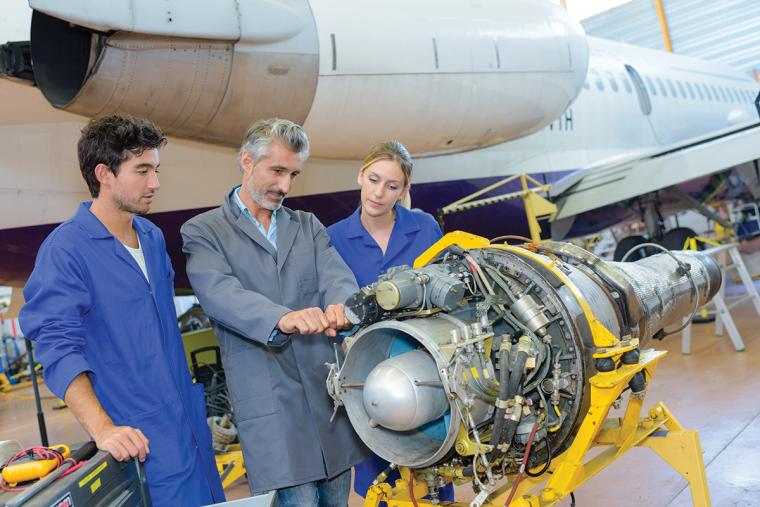

Blockchain technology was an innovation created in the cryptocurrency world as a way to record all actions in a database by grouping them into “blocks.” Each block is secured, time-stamped and unable to be altered, and is linked and is linked to previous blocks. All this data forms a chronological “chain,” which is then distributed in a shared registry—accessible to others in the chain.
“We think blockchain is very important in the aviation/aerospace industry,” says Scott Thompson, the aerospace and defense leader at multinational professional services firm PwC. “It has a lot of potential to drive greater efficiency through the maintenance process and in aviation in general.”
In 2018, aerospace industry revenues were estimated to be $838 billion, with demand for new commercial aircraft continuing to grow. PwC estimates demand will reach about 40,000 planes over the next 20 years. The company also estimates that efficiency gains enabled by blockchain could increase aviation industry revenue by as much as 4 percent a year, or about $40 billion, while cutting maintenance, repair and overhaul costs by about 5 percent annually, or $3.5 billion.
In PwC’s fall 2018 “Digital Trust Insights Survey,” 24 percent of aerospace and defense executives who participated in the study said blockchain was critical to all their lines of business, compared with 20 percent for all respondents across all sectors, according to a recent article by Thompson and colleagues Chuck Marx and Rachel Parker Sealy in the online publication Strategy + Business (www.strategy-business.com).
A Measure of Trust
“Blockchain is a lot about trust,” Thompson says. “In the context of aviation, there is already very high trust, but trust comes at a high cost.” Thompson likens blockchain in the aviation industry to what happens in medicine. If a doctor only knows a person’s age and gender, he or she can only draw very limited conclusions. But when a doctor is able to drill down and get more data and test results on a patient, there is a better chance of predicting that patient’s future health, and future health needs.
“The same is true of aircraft,” Thompson notes. “The more data you have of every single part on an aircraft, you can make better predictions about how this group of parts will fly and perform together. The potential for predictive analytics will soar.”
Depending on its size, an aircraft can have hundreds of thousands of parts, and possibly millions of parts, many of which are highly regulated. Currently, though, information about those parts is highly fragmented, with data often collected manually and spread across a wide ecosystem. There is no readily available, single “snapshot” that can show an aircraft’s history or condition. When maintenance is performed, companies often log records by hand, and those records are then shared in stacks of printouts. If something is missing or incomplete, a part’s airworthiness needs to be established through investigation, testing and recertification—an expensive and time-consuming process.
“With blockchain, you have a snapshot of every part of the aircraft, and you know the history of every part,” Thompson says. The decentralized and consensus-based nature of blockchain makes it perfect for all the data that needs to be collected and analyzed in aviation.
Creating a “Digital Twin”
“At its most basic level, every blockchain is a digital ledger of transactions that take place on a peer-to-peer network with the ability to control visibility—who has permission to see which data,” Thompson and his colleagues wrote in Strategy + Business. “Blockchain offers the capacity to create a digital ‘birth certificate’ for every part and update it each time the part moves through the supply chain or is installed on a plane.”
Information that can be included in a component’s digital record could include the aircraft’s identification number and configuration, the part’s location in the plane, its manufacturer, the identity of each technician who touched that part, the location where the service was performed, even the weather (temperature, humidity, etc.) at the time of service, and more.
Aggregating all these digital records within the blockchain can create a “digital twin” of the aircraft, which can provide a real-time snapshot of its condition from the moment it leaves the assembly line to the day, decades later, when it might be retired from service. “Blockchain enables you to have an exact digital replica” of the craft, Thompson says. All that digitized data can be spread across multiple parties and systems contributing to the blockchain, and the visibility and transparency throughout the supply chain can improve scheduling and performance.
The idea of a digital twin is not new—it’s frequently used to track and maintain offshore oil rig operations—but it isn’t used yet in the aviation industry because the data simply doesn’t exist, Thompson notes. With a digital twin of an aircraft, operators “have a complete set of data for that aircraft and can use Artificial Intelligence and apply modeling. It further improves the safety of the aircraft as well as the predictive analytics to improve its performance and reduce down time,” Thompson adds.
Maintenance and Spare Parts
Blockchain technology can be particularly useful in streamlining the spare parts system. “If an operator needs to find a part, they’ll look in their own inventory and if they don’t have it, they’ll probably call a middleman,” says Thompson. “If the company used blockchain technology, they’d have complete transparency on where every part is and how to find it. It’s very efficient, allows better access to parts and means better pricing through transparency.” Combined with predictive analytics, blockchain also can allow operators to reduce their spare parts inventories.
Having a continually updated log of each part’s condition and usage also can help reduce time spent on routine inspection and maintenance, possibly taking days off heavy maintenance visits, meaning aircraft are back in service faster and labor costs are reduced. Operators also can engage in more “predictive” maintenance, heading off problems before they affect operations, rather than only addressing a problem after it surfaces. This ability to predict the cost of aircraft maintenance on each plane can also alter the economics of maintenance, repair and overhaul (MRO) contracts.
Another area that could be affected by blockchain is the ability to allow original equipment manufacturers to predict the condition and ultimately the lifespan of parts or systems. Manufacturers can then tailor their production processes to make sure replacement parts are available on a “just in time” basis — thereby improving customer service while cutting their own inventory costs.
Of course, blockchain also can be a key when it comes to safety issues. If a part needs to be subbed out or updated, fleet operators can see immediately which planes are affected.
Another safety issue also involves the proliferation of 3-D parts in aviation. “Without blockchain,” Thompson says, “there are significant risks of nonauthentic 3-D parts entering the supply chain. As 3-D printing gets better, it will be easier to create a fraudulent part, which may not have the same safety qualifications. That’s a risk and threat not only to the aircraft, but also to the intellectual property of suppliers creating these parts. Blockchain can ensure that 3-D parts entering the supply chain are authentic.”
Digitizing Workforce Credentials
Blockchain technology also can be used to track every person who comes in contact with a particular plane or fleet, including maintenance and repair workers, pilots, cabin crew, caterers, ground crew, etc.
“Every person who touches that plane has a potential impact on it,” Thompson says. With blockchain, operators can track and confirm a technician’s credentials, certifications, work record, employment history and more — it makes it more practical to ensure the identity and credentials status of every person who interacts with a plane. All this information is recorded and becomes part of the real-time snapshot of the plane’s condition. Parties in the blockchain with the appropriate permissions can then see instantly the verified identity and qualifications of the worker who installed a part or performed a service.
This can have obvious advantages for aviation companies and airlines. If a worker has an issue that might compromise his or her work — for instance, if a person doesn’t have the most up-to-date training on a certain component or system, or if a drug or performance test shows reason for concern — then every aircraft and every part that worker came in contact with will be known to operators and can be available to review.
Finance and Leasing
Blockchain technology also has important implications on the finance side of aviation, as the wealth of data collected and available about a plane’s makeup, usage and maintenance is stored and updated in real time. For instance, on the secondary market, aircraft engines maintained to high standards and that include verifiable authentic parts can bring in premium prices. With blockchain technology, those value advantages can extend to the entire aircraft, giving buyers in the secondary market great confidence in their purchases, which can lead to better prices for sellers.
In leasing, aircraft generally need to be returned in the same condition. Currently, though, at the end of a lease period, “It’s a very manual and painstaking process to go through the plane to make sure it’s all good, and it can take weeks, or even months,” Thompson says. “Blockchain will make that process much more efficient.”
The Importance of Data
This past April, Thompson spoke at the International Civil Aviation Organization’s first Blockchain Aviation Summit and Exhibition, which was held in Abu Dhabi in the United Arab Emirates. In the UAE, says Thompson, the aviation industry is a large part of the economy, so the country recognizes the importance blockchain can play.
The oft-repeated phrase at the conference was, “Data is the new oil,” Thompson notes. “Think about the importance of data. What’s that data worth? What should I get in return? In terms of who gets value out of [blockchain technology], the airlines have a lot to gain—improved safety, efficiency and cost.”
A challenge, of course is that collecting the information needed to best take advantage of blockchain technology requires the cooperation of a lot of parties, Thompson says. “How do you get suppliers to share the information? How do you make sure everyone feels they’re getting something in return for sharing their data?” And importantly, how do airlines and aviation companies get started taking advantage of all that blockchain can offer?
“It’s very daunting,” Thompson says. “You have to start small and experiment with it and prove the value, then expand off that to more suppliers and more data. But because it’s so daunting to sort this out in the beginning, I predict there will be many different blockchains to start with, then they’ll converge down the road.”
Ultimately, while blockchain technology in aviation can lead to many efficiencies, safety and cost-savings, the benefits of sharing data about aircraft history, maintenance and operations all comes down to improving transparency and trust—for all parties involved. T&ID

